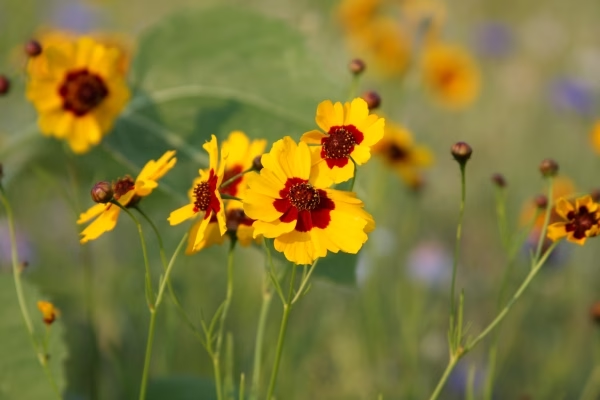
Coreopsis
Botanical Name
:
Coreopsis spp.
Plant Type
:
Herbaceous perennial
Seasons
:
Plant in spring after all risk of frost has passed; Blooms in spring and summer, with some varieties blooming into fall
Sun Level
:
Full sun to light shade; at least 6 hours of full sun daily
Ideal Soil Temperature for Planting
:
60–70°F (15–21°C)
Soil Type
:
Well-drained, average soil; tolerates most soil types
Hardiness Zones
:
3–9 (USDA)
Germination
:
7–14 days (direct sow after last frost or start indoors)
P.H. Level
:
6.0–7.5 (slightly acidic to neutral)
Water/Irrigation
:
Water regularly, especially during dry periods. Once established, they are somewhat drought-tolerant
Fertilization
:
Not typically needed
Habit
:
Upright, branching
Propagation
:
Seed, division (of established clumps in spring or fall)
Final Plant Height
:
1–3 ft
Spread
:
1–2 ft
Flowers
:
Daisy-like, with bright yellow, orange, pink, red, or white petals and a central disc
Attracts
:
Butterflies, bees, and other pollinators
Uses
:
Ornamental (garden beds, borders, cut flowers), pollinator gardens, wildflower meadows
Companions
:
Black-eyed Susan (Rudbeckia), coneflowers (Echinacea), yarrow (Achillea), ornamental grasses
Pruning
:
Deadheading (removing spent flowers) encourages more blooms. Cut back stems in late fall or early spring
Toxicity
:
Generally considered non-toxic to humans and animals
Pests
:
Aphids, slugs, snails, caterpillars
Diseases
:
Powdery mildew, leaf spots, and rust
Additional Info
:
The name “Coreopsis” comes from the Greek words “koris” (bedbug) and “opsis” (view), referring to the shape of the seed head
Botanical Name
:
Coreopsis spp.
Plant Type
:
Herbaceous perennial
Seasons
:
Plant in spring after all risk of frost has passed; Blooms in spring and summer, with some varieties blooming into fall
Sun Level
:
Full sun to light shade; at least 6 hours of full sun daily
Ideal Soil Temperature for Planting
:
60–70°F (15–21°C)
Soil Type
:
Well-drained, average soil; tolerates most soil types
Hardiness Zones
:
3–9 (USDA)
Germination
:
7–14 days (direct sow after last frost or start indoors)
P.H. Level
:
6.0–7.5 (slightly acidic to neutral)
Water/Irrigation
:
Water regularly, especially during dry periods. Once established, they are somewhat drought-tolerant
Fertilization
:
Not typically needed
Habit
:
Upright, branching
Propagation
:
Seed, division (of established clumps in spring or fall)
Final Plant Height
:
1–3 ft
Spread
:
1–2 ft
Flowers
:
Daisy-like, with bright yellow, orange, pink, red, or white petals and a central disc
Attracts
:
Butterflies, bees, and other pollinators
Uses
:
Ornamental (garden beds, borders, cut flowers), pollinator gardens, wildflower meadows
Companions
:
Black-eyed Susan (Rudbeckia), coneflowers (Echinacea), yarrow (Achillea), ornamental grasses
Pruning
:
Deadheading (removing spent flowers) encourages more blooms. Cut back stems in late fall or early spring
Toxicity
:
Generally considered non-toxic to humans and animals
Pests
:
Aphids, slugs, snails, caterpillars
Diseases
:
Powdery mildew, leaf spots, and rust
Additional Info
:
The name “Coreopsis” comes from the Greek words “koris” (bedbug) and “opsis” (view), referring to the shape of the seed head
Written by Nondiah Khalayi – https://www.linkedin.com/in/nondiah-khalayi/

